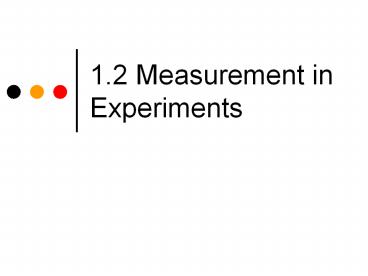1.2 Measurement in Experiments - PowerPoint PPT Presentation
Title:
1.2 Measurement in Experiments
Description:
1.2 Measurement in Experiments Learning Objectives List basic SI units and quantities they describe Convert measurements to scientific notation Distinguish between ... – PowerPoint PPT presentation
Number of Views:94
Avg rating:3.0/5.0
Title: 1.2 Measurement in Experiments
1
1.2 Measurement in Experiments
2
Learning Objectives
- List basic SI units and quantities they describe
- Convert measurements to scientific notation
- Distinguish between accuracy precision
- Use significant figures in measurements
calculations
3
Numbers as Measurements
- In science, numbers represent measurements
- Numbers involve three things
- Magnitude how much?
- Dimensions length, mass, time
- Units of what?
4
The SI system
- The standard measurement system for science
- Formerly called the metric system
- Base units
- Basic units that are not a combination of some
other units - Derived units
- Are combinations of base units
5
Base Units
Physical Quantity (Dimension) Unit Abbreviation
Mass Kilogram kg
Length Meter m
Time Second s
Electric current Ampere A
Temperature Kelvin K
Luminous intensity Candela cd
Amount of substance Mole mol
6
Derived units
- Derived units are combinations of base units
Base Unit Derived Unit
m (length) m3 (volume)
kg (mass) m (length) s (time) N (newton) for force 1N 1 kgm s2
7
Prefixes indicate orders of magnitude (powers of
10)
Power Prefix Abbrev Power Prefix Abbrev
10 -18 atto- a 10 -1 deci- d
10 -15 femto- f 10 1 deka- da
10 -12 pico- p 10 3 kilo- k
10 -9 nano- n 10 6 mega- M
10 -6 micro- µ 10 9 giga- G
10 -3 milli- m 10 12 tera- T
10 -2 centi- c 10 15 peta- P
8
Converting Prefixes Units
- The main idea multiply the given unit by a
conversion factor yielding the desired unit - Conversion factor a ratio of two units that is
an equivalent to 1. - Example convert millimeters to meters
- 1 mm x 10-3 m 1 x 10-3 m
- 1 mm
- Practice 1A, 1-5
9
Converting units of area and units of volume
- How many cm2 are in 1 m2?
- How many cm3 are in 1 m3?
- How many in3 are in 1 L?
- 1 in 2.54 cm
- 1 L 103 mL
- 1 mL 1 cm3
10
Scientific Method
A way of thinking and problem solving A group of
related processes and activities
http//www.sciencebuddies.org/science-fair-project
s/overview_scientific_method2.gif
11
Scientific Method Important Terms
- Law vs. Theory
- Fact / Observation
- Hypothesis
- Experiment
12
Accuracy Precision
- Accuracy
- Nearness of a measurement to the true value
- Precision
- Degree of exactness or refinement of a
measurement - Repeatability of a measurement
13
Precision
- describes the limit of exactness of a measuring
instrument - Significant figures reflect certainty of a
measurement - Are figures that are known because they are
measured
14
Uncertainty in Measurement
- No measurement is absolutely correct
- All measurements are approximations
- Estimated uncertainty
- ½ smallest increment of the instrument
- E.g. a ruler graduated in 0.1 cm units would be
reported as 5.2 0.05 cm
15
Estimated UncertaintyPercent Uncertainty
- Estimated uncertainty
- smallest increment of measurement
- E.g. a ruler graduated in 0.1 cm units would be
reported as 5.2 0.1 cm - Percent uncertainty
- ratio of estimated uncertainty to measurement
- E.g. 0.05/5.2 0.96
- Measurement is reported as 5.2 0.96
16
Is this diamond yours?
- You have a diamond with a mass of 8.17 grams,
measured on a scale with a precision of 0.05g - You lend the diamond to a friend, who returns it.
The returned diamond measures 8.09 g - Is the diamond yours?
17
Significant Figures
- Represent measured numbers and one final
estimated digit - Reflect the precision of an instrument
- Must be reported properly
- Require special handling in calculations
18
Rules to determine significant digits
- 1. All non-zeros ARE
- 2. All zeros between non-zeros ARE
- 3. Zeros in front of non-zeros ARE NOT
- 4. Final zeros to right of decimal ARE
- 5. Final zeros without a decimal ARE NOT
- 6. Final zeros to left of decimal ARE
19
How many significant figures?
- 50.3 20.001
- 3.0025 3426
- 0.892 210
- 0.0008 6.58 x 103
- 57.00 1.534 x 10-4
- 2.000000 2.00 x 107
- 1000 5000.
- 20. 30
20
Rules of calculating with significant figures
- When adding subtracting, final answer must have
fewest decimal places present in the calculation. - When multiplying dividing, final answer must
have fewest significant digits present in the
calculation. - Number of figures in a constant are ignored wrt
sig figs.
21
1.3 Language of Physics
- Mathematics is the language of physics
- Data is collected in a table form
- Data is graphed to show relationship of
independent dependent variables
22
Data Table and Graph
Determining k through displacement Determining k through displacement Determining k through displacement
x (m) Force (N) mass (kg)
0.00 0.00 0.00
0.01 0.49 0.05
0.03 0.98 0.10
0.06 1.47 0.15
0.09 1.96 0.20
23
Equations
- Equations indicate relationships of variables
24
Evaluating Physics Equations
- Dimensional analysis can give you clues how to
solve a problem - Dimensional analysis can help check many types of
problems because - Dimensions can be treated as algebraic quantities
- Example derive a formula for speed
- Example How long would it take a car to travel
725 km at a speed of 88 km/h?
25
Order of Magnitude Estimates
- Physics often uses very large and very small
numbers - Using powers of ten as estimates of the numbers
can help estimate and check your answers - Example from the previous problem,

